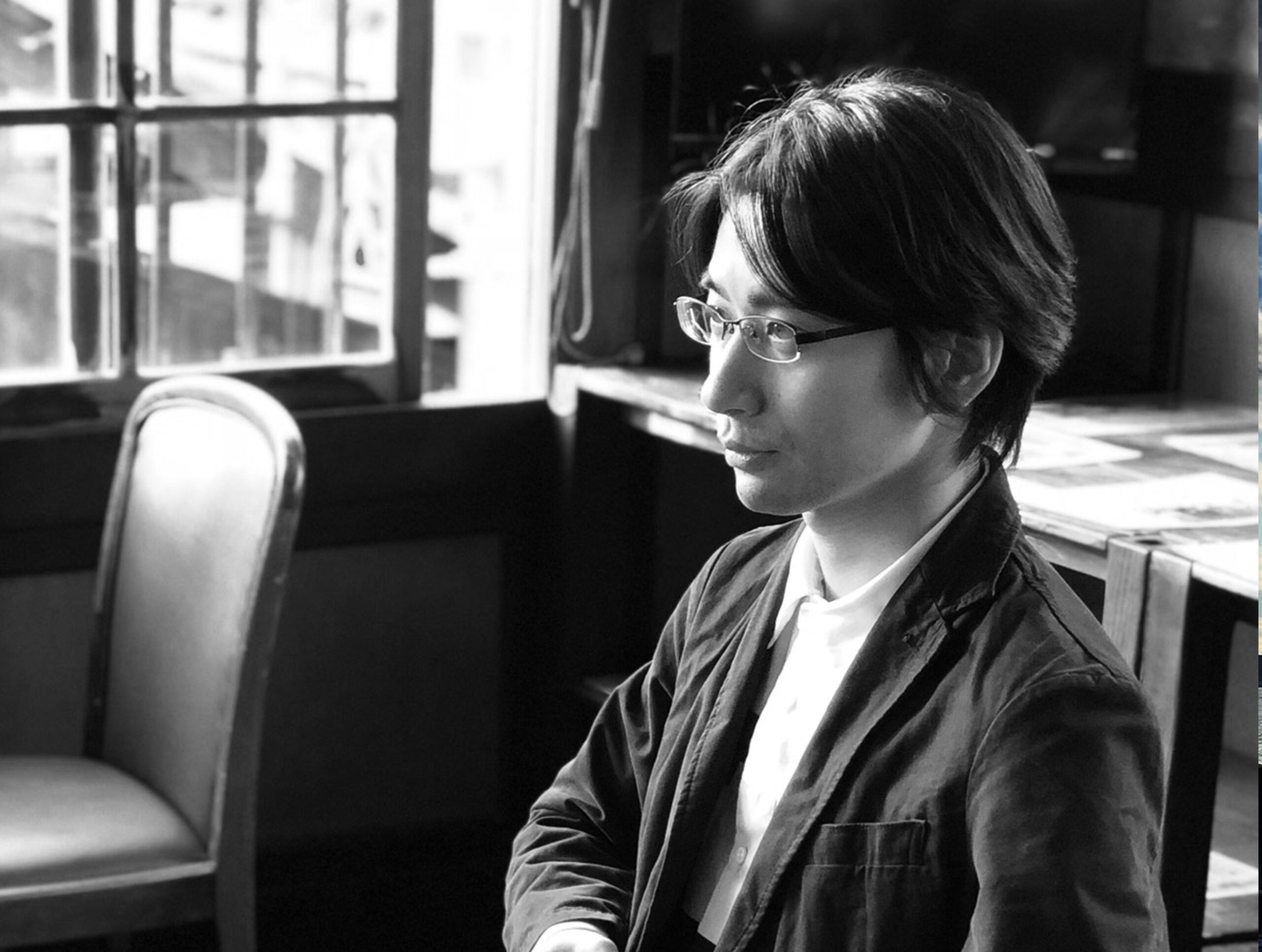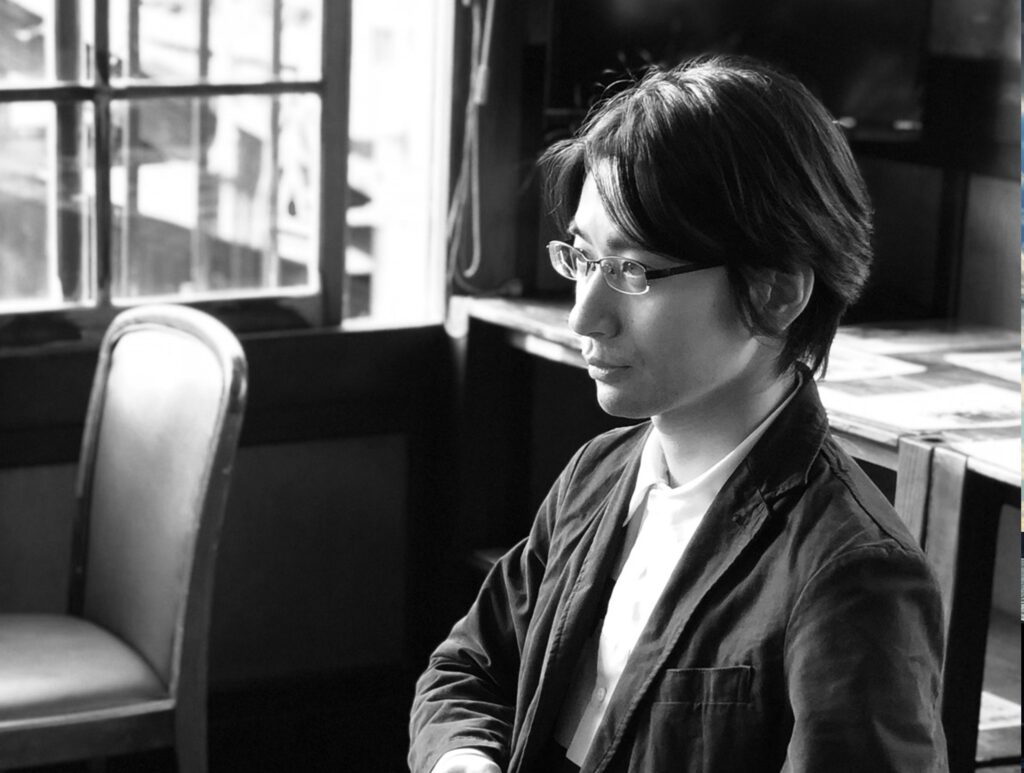
Interview with artist Yuki Saito. Please enjoy reading about Yuki Saito’s life, which is as unique as his art. Interview by the FFD editorial team!
Interview with artist Yuki Saito. The boy who preferred to draw than to speak went on to become a popular artist (part 1)
On noticing the difference between a picture and a work of art
Thank you for your time today. I’d like to start by asking when you first encountered paintings.
I’ve been looking forward to this question! I don’t remember much from my childhood. My parents told me that I was the kind of kid who would watch TV and doodle on the back of scrap paper whenever a commercial came on.
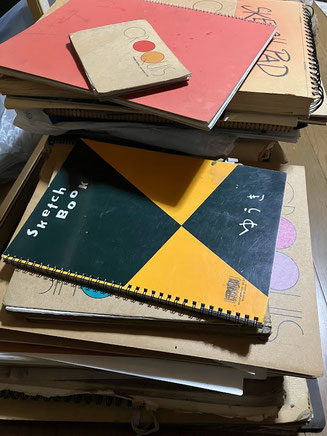
When did you think about becoming an artist?
I liked to draw so much, I remember saying that I wanted to become an artist by the time I was in elementary school, but it wasn’t until 8th grade that I decided on becoming one. There was a specific event.
Could you elaborate?
In one art class, we were assigned to make a self-portrait. My view of the ‘self’ was ‘something that continuously changes’ and that it’s an extension of my own evolution. I decided to paint a self-portrait using time as a theme. The work itself may not have been great, but it came together in my own style.
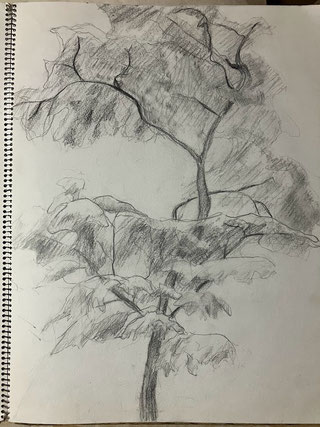
Until then, the subjects of my drawings were all pictorial, such as flowers and landscapes. This assignment made me realize that I could create concrete works of art about abstract and conceptual subjects. I was excited to discover that making art is something that would interest me for the rest of my life!
That’s when I knew I wanted to become an artist at the age of 14, and later joined the art club in high school.
I wasn’t very articulate
How did you spend your time in the art club in high school?
People may find it hard to believe now, but I wasn’t very articulate back then.
That’s difficult to imagine, you seem to be a natural at it.
In high school, even if I had something to say, I had a hard time verbalizing it. All that would come out of my mouth were filler words like “Um” or “Ah”. I’m sure people thought me odd, because my hands would move around, but not my mouth, especially when it came to talking about art. My high school art teacher helped me find my words, asking questions like, “hmm… is this what you’re trying to convey?”.
He would guide the conversation in a way that allowed me to vocalize my thoughts. He was a brilliant teacher — actually, now that I think about it, he was a genius at teaching.
Having someone like that as your teacher makes a difference.
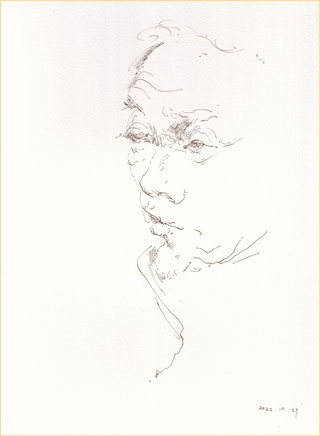
My teacher wasn’t just good to me, but to the other students as well. He was a good listener and gave advice when needed, without judgment. He was well loved by everyone. I still keep in touch with him to this day.
It must have meant a huge deal to have your teacher understand you as an artist.
Yes, the influence was huge. Our club had other students who later became artists, such as Azusa Seshimo (Nihonga) and Makoto Fujii (western art).
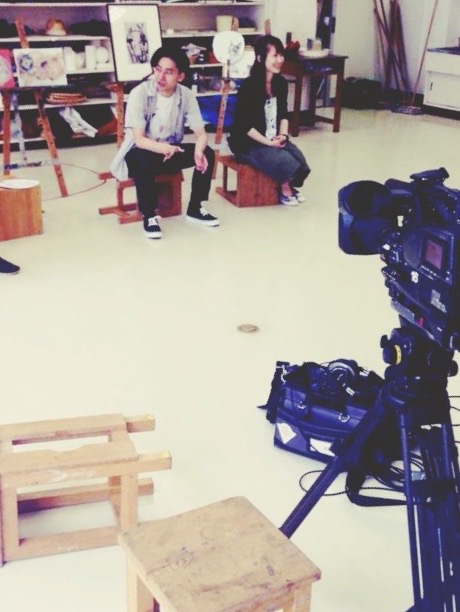
I think he’s a memorable teacher for all of us.
The Cave of the Hands speaks out to me, “I’m here!”
That’s a truly remarkable teacher. How did you come to be such an expressive speaker?
I think my becoming a teacher has a lot to do with that. I taught part-time at a local public high school for nine years.
In class, I want my students to be drawn to art. In order to do so, I needed to bridge the gap between students by being respectful, speaking in accessible language and providing examples that are easy for them to understand. We spoke about “what we paint” and “why we need to do these things” together.
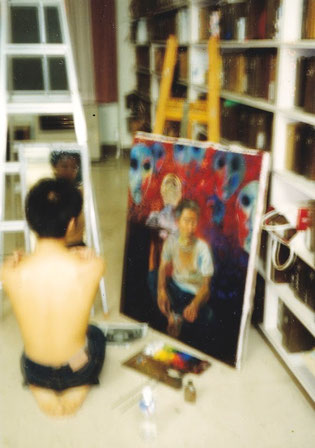
If people can be convinced of the reasons for doing something, they will take action voluntarily because they believe it’s worthwhile.
As a teacher, two things were important to me. The first was stressing the importance of painting, and the second was to remember the names of my students. Over the nine years of teaching, I think I became better at speaking.
Can you tell us the reason you talked with your students about why we need to paint?
Actually, the answer depends on who I’m talking to, according to where they were in their art journey. The question has a different nuance coming from a child in their early teens versus coming from an established artist, even though they’re using the exact same phrase.
There was a student who said “painting is a hobby only for rich folks who can afford it”. I think that might be a one-sided view of things.
In ancient times, death was viewed as an integral part of life. How many modern day high school students spend time thinking about the meaning of paintings from a prehistoric context? For example, I think of a painting of what at first glance, looks like someone spray painted the outline of hands in a cave.
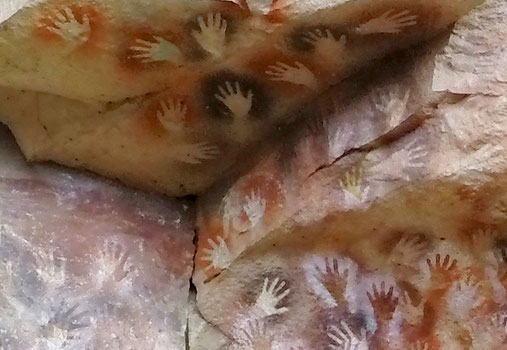
I feel deeply moved whenever I see that.
I feel certain someone wanted to leave their mark on the wall as if to say, “I’m here!”. I can really relate to it, and I feel like I understand it. The shape of your hand is different for every person.
Someone wanted to leave a mark that said, “Here I was”. That’s art.
I understand you.
When I see the Cave of the Hands, I feel so inspired and connected and feel that “even after thousands or tens of thousands of years, humans are still the same”, and that we’re somehow still connected through history. I think this is part of the reason why people continue to paint.
What an interesting perspective.
Art is interesting!
Your art club must have been a fascinating place.
I was fortunate to have great friends in the art club. We would set a period of 2-3 months to work on our art and say “Let’s have a group critique” at the end, where we laid out everyone’s paintings side by side. We would work hard to meet the deadline, present our art, and listen to other people’s opinions and critiques.
You can’t have a critique session unless you have a good relationship with others. If you try to hold a critique before you’ve built up trust, the relationship is fragile and liable to break.
We were all able to offer opinions because we had a good foundation of trust and felt comfortable with each other. Being able to express myself and experience confronting myself was very meaningful in my life. Perhaps the critiques with my friends were the first steps to becoming an artist.
I’ll pay whatever it costs, because I can tell he’s going to be an artist.
I showed my art not only to those within the art club but also those outside it.
I was interested in learning how to garner interest from others, and to understand how my work would be viewed by others. To gain experience, I would sometimes hold exhibitions outside of school.
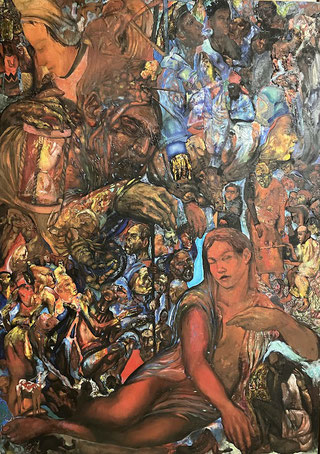
These exhibitions were held in a rented space above a bookstore once a year. It took me 2-3 years to get into a fine arts program, so I ended up hosting them for several years.
That’s not very different from what you do now, especially if you were putting a price and selling the paintings.
When one of my paintings was displayed at the school festival, the mother of another student came up and asked to buy the painting, telling me, “I don’t care how much it costs, I want to buy this painting”. That was the first time I was faced with the concept of ‘pricing’ paintings — I was in 12th grade.
She said, “He’s going to be an artist; you can tell by looking at his paintings”.
She bought my painting, not her own child’s.
Her child told me that she still has that painting hanging in her foyer. He laughed and said, “my painting isn’t on a wall”.
She had a sharp eye!
Yes, I was equally surprised and happy.
I’m curious to know how you went about pricing your painting.
I simply doubled my allowance at that time, although I don’t remember how much it was.
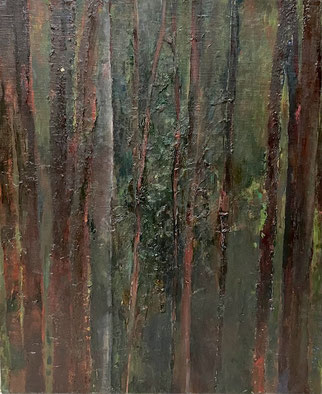
Was there any significance in that value?
I just thought I would be happy to get two months’ worth of spending money! I remember thinking that I didn’t want to set the price too low, and I didn’t want to sell it at just any price. I was a cheeky 18 year old!
I can’t imagine you as anything other than an artist.
That may be true, I’ve never thought of doing anything other than painting.
So, you sold your first painting as a high school senior. What was life like in university?
I spent a few years getting into university.
Oh, really?!
Life didn’t go that smoothly.

→ continued in <part 2> “Saito’s drawings are extraordinary, but his oil paintings are devastating”
A day in the life, Yuki Saito’s daily routine
We’re going to follow what a day in the life of an artist consists of. How does a painter spend his day? We hope to capture what a day in the life of a painter is like.
(Written and illustrated by Yuki Saito)
6:00 Wake up and immediately work on a piece
I focus on decisions that need to be made and get started there.
● Trial print for a new woodblock print
● Decide on a new frame
● Decide on the composition of a new work I’m thinking of, then start to paint
12:00 Lunch
13:00 After lunch, I start working on a bigger piece or a piece in progress.
17:00 Coffee break in the evening. I drink from a Bizen cup given to me by a collector. The collector has since passed on from this world, and I’m heartbroken that I won’t be able to see them again. I often think back on how much encouragement they offered me as I work on my new art piece in my studio.
18:30 Dinner
20:00 In the evening, I make print editions of copperplate engravings.
The wooden handle attached to the press was originally given to us by a senior artist friend, which I had customized at an ironworks company. The handle gets better with use and age.
I also spend the evening doing the following:
Making Kibukuro (yellow bag used to store antiques and framed paintings)
Assembling boxes to store painting frames
Work on the computer
Cleaning the studio
23:00 Go to bed
The schedule may vary by day.
Layered glass paintings, interview on the study of history, painting materials and techniques
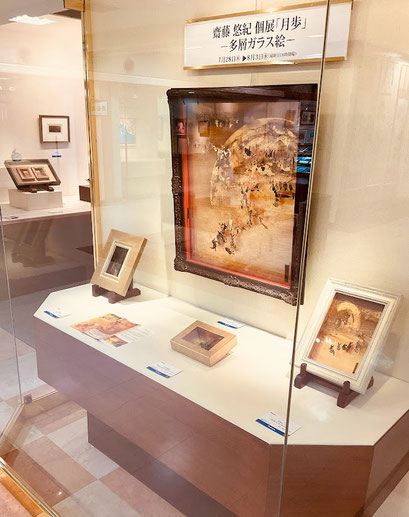
Recently, layered glass paintings have gained popularity. We asked the artist Yuki Saito how he got into layered glass paintings.
Layered glass paintings, interview on the study of history
My idea came from the image of the sliding fusuma and shoji (Japanese sliding door using washi) that I originally worked on in my copperplate engraving art. The multiplicity of the real world is one of the themes of layered glass painting.
The relationship between the self and others is a reflection of society itself.
The reason he’s been interested in the multi-layered aspect is because he feels that art reflects society.
When there’s a sheet of printing paper in front of another piece of art, you can’t see the picture on the sheet in the back. If you use transparent glass in place of the paper, then the picture in the back becomes visible.
By using glass, which was unavailable in the era of emaki (handscrolls), it’s now possible for Saito to create multi-layered expressions. Experimenting with new materials and techniques is important in order for artists to incorporate and convey their own themes through art.

We also asked him about the theme he’s currently considering.
I use the multi-layered aspect as well as the theme of time within my work. This is based on the expression of time associated with the emaki such as Choju Giga (Animal Caricatures).
Hold the emaki scroll with both hands and take a look at the illustrations. You can see the illustration as you unwind it, thereby providing a horizontal flow structure that expresses time spatially.
I wanted to reinterpret the emaki scroll in my own way.
In a folded form, I would make it into one single drawing.
If you view it from the front all the way through, you end up with a single point of view, but the viewer can move around wherever they want within the painting. It’s also possible to incorporate a time and spatial element of the emaki scroll into the painting.
In his layered glass painting, there are numerous rabbits that appear, as in the Choju Giga scroll. Saito painted the rabbits to show that he was paying homage to the emaki scroll format.
We asked Saito if he meant to trap time in his layered glass paintings.
It’s not the same as confining time within the painting … I wanted my painting to show that it’s possible to depict a sense of time. For example, if you draw a line from left to right, you can see the line continuing to grow from the tip of the pen on the right side, whereas the left side is the remnants of the line. The story of the rabbits is also an expression of linear time.
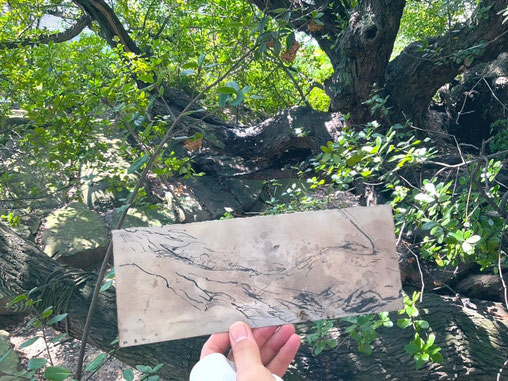
This reminded me of a story Saito told me about when he was in middle school and decided to become a painter. In art class, he was given an assignment to draw a self-portrait. At the time, he wondered what the ‘self’ was, eventually deciding that it was something that continues to change, and that the ‘self’ was an extension of his evolution. That was the reason he decided to paint a self-portrait on the theme of time.

As a middle school student, Saito said “I continue to change and evolve”. If we were to compare Saito’s life to a single line, right now he is the portion of the line that had just blossomed from the tip of the pen. He will continue to draw lines that will continue to evolve, so there’s no telling what he might bring forth in the future.
I use the word ‘expression of time’, but there are many parts I don’t fully understand. I’ve been through so many cycles of creation and reflection, only to look back years later and just realize then what I was drawn to.
The story of the rabbits in the layered glass painting is one that doesn’t have a definite ending. It gives the impression that the future of the story is not set in stone.
In that aspect, I realize that the expression I used — “trapping time in a work of art” — wasn’t appropriate. Like the ever-changing artist himself, time isn’t something that can be confined.
I would like to continue following the work of Yuki Saito, as he examines society through layered glass paintings.
(FFD)
Layered glass paintings, interview on the materials and techniques
It’s difficult to understand how layered glass paintings are created at first glance. We asked Saito about the materials and techniques required in layered glass painting.
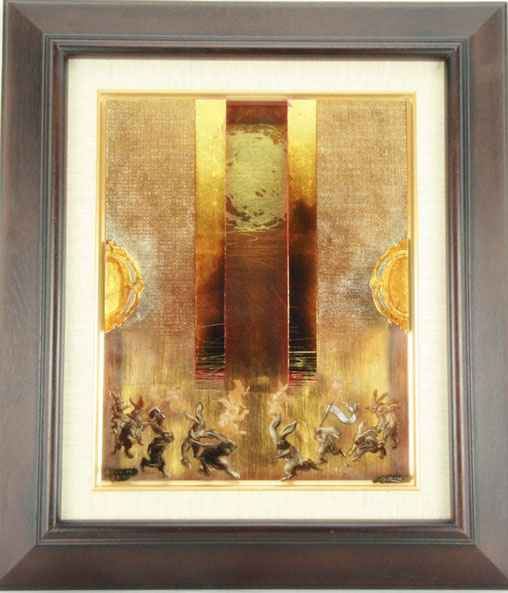
“I was originally a copperplate engraver. Layered glass paintings use the same technique.”
How does he paint on transparent glass?
“First, I apply a ground on glass (ground is a substance used in copperplate engravings that slows down deterioration. A type of mask that looks like soy sauce, light brown and semi-translucent, mainly composed of asphalt and beeswax, wax). It’s wax, so it can be scraped off when it dries. If I used oil, it would harden and be impossible to scrape off. The black rabbit is the ground left without having been scraped off. I then mix soot with the ground to adjust the density, and the amount of ground scraped off can change the effect it gives. For example, the black rabbit’s color is when the ground is fully scraped off, while the white rabbit is if it’s mostly scraped off, and the midtone rabbit is somewhere in-between the two. This allows me to freely express spatial elements in my painting.”
The glass at the very front (closest to the viewer) has been ground down considerably.
“I scrape off the ground of the glass in the foreground considerably, because otherwise it would obscure the glass at the very back. Obviously, this means there’s a restriction on what you can do with the image. The glass in the back is entirely solid and the image is drawn by scraping the ground.”
The layered glass painting in the photo “Invitation of the night lines” has 3 layers. Using this as an example, he explains each layer.
“The first layer (closest to the viewer) depicts a shoji, a pull, a black rabbit, and white rabbits in the foreground. The second layer shows only a few white rabbits. Most of the glass is transparent. The third layer towards the back has the moon and white rabbits.”
I understand, but it’s the kind of art that’s best seen in person or as a video.
Artist Yuki Saito bio, awards, and exhibitions

Yuki Saito
<Bio>
1982 Born in Saitama
2008 Completed Design Education and Research Field, Tokyo Zokei University, Graduate School of Fine Arts
<Museums>
Japan, USA, China, South Korea, Taiwan, France, Poland, Romania, Spain
<Department Stores>
Ginza Mitsukoshi, Isetan Urawa, Isetan Shinjuku, Tokyu Tama Plaza, Fukuya Hatchobori, Hanshin, Tobu Ikebukuro
Exhibited at galleries nationwide.
Layered glass paintings and copperplate engravings
<Recent Exhibitions>
2022 Yoru to Hana (The night and flower), Takatsuki Hankyu
Layered glass painting, copperplate engravings, Art Zone Kaguraoka, Kyoto
Yobanashi, Art Gallery Muse, Gunma
Geppo, Fukuya Hatchobori Main Building
2021 Mijikayo, Isetan Urawa
2020 Yakou, Fukuya Hatchobori Main Building Gallery 101
2019 Kunpu, Hanshin Umeda
Yukikau, Isetan Urawa
2018 Miruna no Zashiki, Ginza Mitsukoshi
2017 Hikari no Ito, Isetan Urawa
Nowo Shitamu, Tokyu Department Store Tama Plaza
2016 No aida, Isetan Shinjuku
Aketate, Isetan Urawa
Hone no Mori no Naka de, Yanagisawa Gallery, Saitama
Hitoma no Hyouhaku, Art Gallery Muse, Maebashi
2014 Stranding Cafe, Sawyer Cafe, Nishi-Ogikubo
2013 Byou-Byou, Yanagisawa Gallery
2012 Kansoku Goya, Gallery Uehara, Shibuya
Tadayou Tenkyu, Isetan Urawa
Kansoku, Youseido Gallery, Ginza
<Awards>
2009 The International Space Triennale Print Exhibition, Purchase Prize, Seoul Museum of Art, Korea
2007 PRINTS TOKYO 2007, Special Judge Prize , Tokyo Metropolitan Art Museum, Ueno
2005 The 5th International Mini-Print Biennial Cluj, Honorable Mention, The Art Museum of Cluj-Napoca, Romania
The 12th International Mini-Print Triennial Lodzi, Honorable Mention, Willa Gallery, Poland
<Public Collection>
Willa Gallery, Museum of Cluj-Napoca, Tokyo Zokei University library (Hachioji), Urawa Art Museum (Saitama), Kanuma Municipal Art Museum of Kawakami Sumio, Machida City Museum of Graphic Arts, National Taiwan Museum of Fine Arts (Taiwan), MECCA DESIGN GROUP (Korea), Manga Museum of Japanese Art and Technology (Poland)
Description of Yuki Saito’s work, Moon Play – Sky Mirror –

Moon Play – Sky Mirror – is a popular work in Yuki Saito’s layered glass paintings series.
This work depicts a lunar eclipse. The focus of this piece is not on which is the moon and which is the sun, but rather on their relationship to each other.
From Earth, we see the moon waxing and waning, but the moon itself is always round. The waxing and waning is just due to the sun’s rays not reaching the moon due to the Earth’s movements.
The artist expresses this in the space between the sliding doors. The celestial bodies are painted on each layer of the sliding doors, emphasizing how the view of the moon changes from each perspective. It doesn’t mean that either is true or false, but that they mutually influence each other.
The pulls of the sliding doors and the backs of the rabbits are painted red. We can sense the presence of the color even from the front, though very faint. The rabbit appears red when seen from the celestial body depicted on the glass in the back. The reverse side of the pull also appears to be red when seen from the moon.
Each of the three layers of glass depict a rabbit and a star. The silhouette of the rabbit is reflected in the star, which appears to be the moon. The presence of the sun can be seen in the foreground. The sun is not painted, but it’s there. The rabbit is a shadow, but inverted. There are stories of black rabbits on the moon, but it may originally have been a shadow, just like a lunar eclipse.
The ability to depict viewpoints from various perspectives using layers of glass and the reverse side of the glass is a characteristic of layered glass painting.
The artist’s ability to incorporate various viewpoints while maintaining exquisite harmony throughout the work as a whole is the characteristic of this artist.
(description by FFD)
Details of Yuki Saito’s exhibition
Coming soon…
